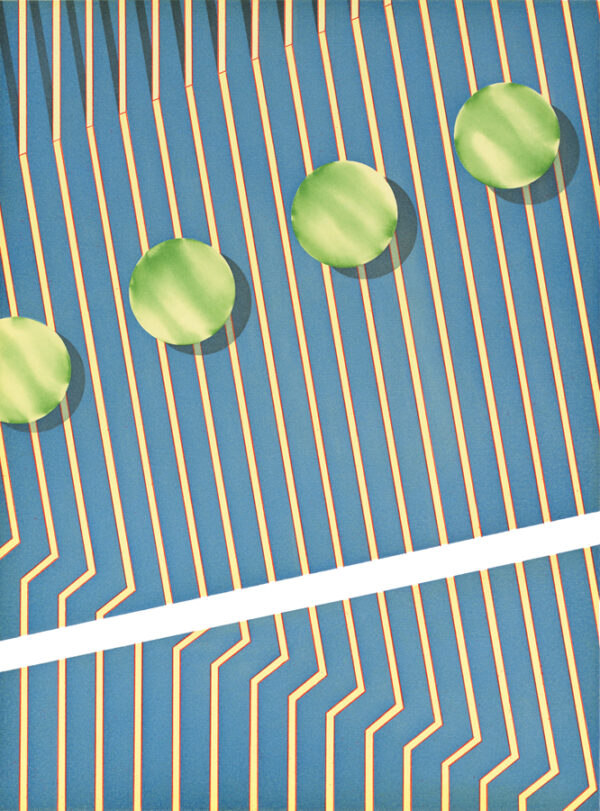In The New York Times in 2008, critic Holland Cotter described Tomma Abts’ paintings as “intensely absorbing.” He continued his review in this way: “Basic, formal elements like stripes, arcs, circles, planes and polygons are carefully layered, juxtaposed and interwoven in all sorts of subtly eccentric ways. Ms. Abts’s colors are muted but seductive, and she adds highlights and shadows creating mysterious, three-dimensional illusions.”
Tomma Abts was born in Kiel, Germany in 1967 and has been based in London since 1995. In 2006 she was awarded the Turner Prize by the Tate Modern in London. In 2008, her first solo exhibition in the United States was held at the New Museum of Contemporary Art in New York, and traveled to the Hammer Museum in Los Angeles. In an interview that year, Abts spoke about her wish to seek the “art of the future” in the present.
Abts applies numerous successive layers of paint to her canvases and works on each painting over many months, even years. She titles her finely calibrated paintings by consulting a book of German first names such as Obbe, Ert, or Mehm. This lends a portrait-like character to the works. “Why are these paintings so memorable?” asks Adrian Searle in The Guardian. “I think it is because of their evident conviction, the restraint and reserve with which each is delivered. Every painting is unmistakably by its author, each quite unlike its neighbor. The world Abts depicts is utterly consistent, even with all its anomalies and flaws.”
In 2016, Abts began experimenting outside her usual self-imposed parameters, adjusting her approaches to size and process. In previous paintings, she had worked entirely freehand and used no source material, allowing intuition to be her guide. For this recent body of work, she established predetermined compositions and made one-to-one scale drawings, using only stripes as structure. She almost doubled the size of her paintings, using 34-by-25-inch canvases, sometimes with the corners rounded or cut diagonally. She then titled the finished paintings with roman numerals instead of using German names. The imagery, although formed under new constraints, continues to represent her quintessential painting style and offers an ongoing study of her attention to detail and her manipulation of illusory space.
Critics have endeavored to describe Abts’ abstract canvases as having the appearance of “mask-like faces,” “biomorphic abstractions,” “architectural constructs,” or (as described in The Guardian in 2006) “scored and folded papers, struggling to achieve three dimensions.” Abts talks about her work in this way: “I develop something without any preconceptions of what it is going to look like, so, to give it a meaning and sense of self-evidence, I try to define the forms precisely. They become, through the shadows, texture, etc., quite physical and therefore ‘real’ and not an image of something else. The forms don’t stand for anything else; they don’t symbolize anything or describe anything outside of painting. They represent themselves.”
Abts has had solo exhibitions at the Art Institute of Chicago (2018); the Aspen Art Museum (2014); the New Museum of Contemporary Art, New York (2008); the Kunsthalle Kiel, Germany (2006); and the Kunsthalle Basel, Switzerland (2005). Her work has been included in major international exhibitions such as the Berlin Biennial (2006), the Carnegie International in Pittsburgh (2004), and the Istanbul Biennial (2001). She is represented by greengrassi in London and David Zwirner in New York.








